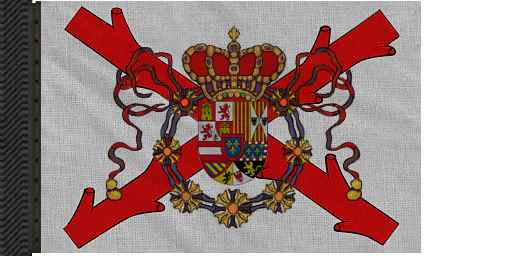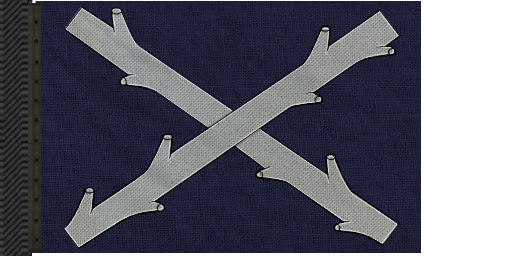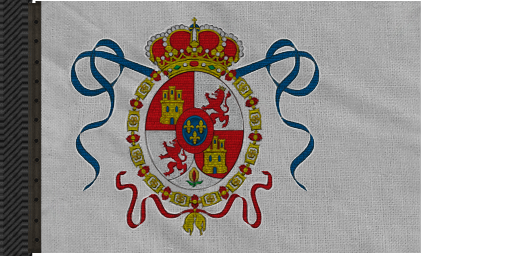FLAGS OF Spain
Spain national Flag
The naval ensign of the Spanish Empire since 1785. The new and distinct design of the flag was created by King Charles III of Spain. The flag was used on warships of the Empire. It consists of the arms of Castile and Leon and two red stripes equally close to the top and bottom on a golden background.
Bandera de Corso
The flag of Spanish privateers. The flag was used by Spanish privateers until the middle of the eighteenth century. The flag consists of the red Cross of Burgundy - the emblem adopted by Habsburgs to use in Spanish Navy since the sixteenth century - and the coat of arms of King Phillip V of Spain on a white background.
Buques Mercantes 1748 Flag
The general civil ensign of the Spanish Empire. The flag was used on trade ships of the Empire until the second half of the eighteenth century. It consists of a blue background and the white Cross of Burgundy - the emblem adopted by Habsburgs to use in Spanish Navy since the sixteenth century.
Buques Mercantes 1762 Flag
The blue civil ensign of the Spanish Empire. The flag was used on trade ships of the Empire till 1762. It consists of a blue background and the white Cross of Burgundy - the emblem adopted by Habsburgs to use in Spanish Navy since the sixteenth century.
Burgundy Cross Yellow Flag
The Cross of Burgundy flag - yellow variant. The emblem of the wooden Saint Andrew cross was adopted by Habsburgs to use in Spanish Navy in the sixteenth century. The flag consists of two crossed saw-toothed red stripes on a golden background.
Burgundy Cross Flag
The Cross of Burgundy flag. The emblem of the wooden Saint Andrew cross was adopted by Habsburgs to use in Spanish Navy in the sixteenth century. The flag consists of two crossed saw-toothed red stripes on a white background.
El Ferrol 1760 Flag
The flag of the Ferrol Squadron. The flag was commissioned in the first half of the eighteenth century. It was used on ships belonging to the Ferrol Naval Base. The flag consists of The Cross of Burgundy - the emblem adopted by Habsburgs to use in the Spanish Navy since the sixteenth century - and four golden anchors aligned to edges of the Cross on a white background.
Etiquette Flag 1701
The etiquette's naval ensign 1701–1760. The flag was established by King Phillip V of Spain and was used within Spanish Navy alongside the general navy flag. Once the monarchy dynasty in Spain was changed from Habsburgs to Bourbons, the Naval flag was changed as well - from the Cross of Burgundy to a Royal coat of arms with four red ribbons on a white background.
Etiquette Flag 1760
The etiquette's naval ensign 1760–1785. The flag was initially established by King Charles III of Spain and was used within Spanish Navy alongside the general navy flag. Once the monarchy dynasty in Spain was changed from Habsburgs to Bourbons, the Naval flag was changed as well - from the Cross of Burgundy to a Royal coat of arms with four red ribbons on a white background.
Flandes Flag
The civil ensign of the Spanish Netherlands. The flag was used by merchant ships within the Spanish Netherlands since the sixteenth century. The flag consists of The Cross of Burgundy - the emblem adopted by Habsburgs to use in Spanish Navy since the sixteenth century - and alternating white and blue stripes, seven of each type.
Gibraltar Flag 1782
The naval flag during the Great Siege of Gibraltar. The flag was used on some of Spanish ships during the siege. It consists of the red Cross of Burgundy - the emblem adopted by Habsburgs to use in Spanish Navy since the sixteenth century - and the Royal coat of arms on a white background.
Merchant Flag
The civil ensign of the Spanish Empire since 1785. The new and distinct design of the flag was created by King Charles III of Spain. The flag was used on trade ships of the Empire. It consists of two red stripes equally close to the top and bottom on a golden background.
Naval Ensign 1701
The naval ensign 1701–1785. The general Navy Flag of the Spanish Navy. Once the monarchy dynasty in Spain was changed from Habsburgs to Bourbons, the Naval flag was changed as well - from the Cross of Burgundy to a Royal coat of arms with two blue and two red ribbons on a white background.












